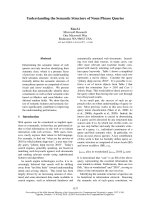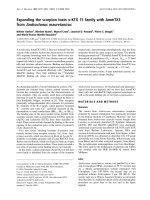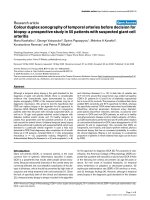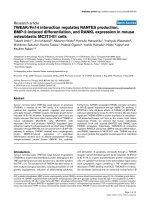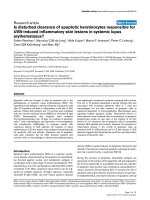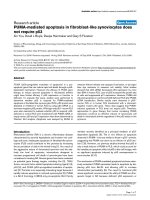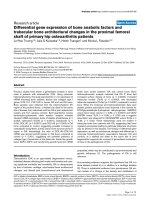Báo cáo y học: "Understanding the roles of the transcription factors nuclear κ α factor-κB and hypoxia-inducible factor-1α in lung injury" pptx
Bạn đang xem bản rút gọn của tài liệu. Xem và tải ngay bản đầy đủ của tài liệu tại đây (36.83 KB, 2 trang )
471
HIF = hypoxia-inducible factor; NF-κB = nuclear factor-κB; VEGF = vascular endothelial growth factor.
Available online />In this and the next issue of Critical Care, John Haddad [1,2]
presents a comprehensive review on the contributions of
transcription factors to lung injury. The topic is large and ever
changing, and the complete coverage of nuclear factor-κB
(NF-κB) and hypoxia-inducible factor (HIF)-1α is spread over
two issues. In critical care approximately 80% of patients
with sepsis develop an acute lung injury [3]. The majority of
these patients progress to the point at which they require
intubation and mechanical ventilation, with an associated
high mortality. Recent studies [4] have demonstrated that low
tidal volume (6 ml/kg) ventilation strategies dramatically
reduce this mortality. However, many other clinical trials of
various treatments have failed at either reducing the lung
injury or accelerating the healing to the end-point of reduced
mortality [5].
In this age of genomics and proteomics we continue to
explore the association of gene and environment. With
respect to lung injury, we need to identify and understand the
mechanisms that predispose patients to the excessive
inflammation resulting from an overactive innate immune
response that characterizes sepsis and lung injury. These
include stimuli, signal transduction (receptors, enzyme
cascades, transcription factors), gene(s) response and the
measured clinical phenotype. John Haddad [1,2], in his two-
part review, identifies many ‘clinical stimuli’ in cell culture,
animal model and patient studies representing an oxidative
stress that can generate a response via NF-κB or HIF-1α
dependent signalling.
Nuclear factor-
κκ
B: response to stimuli
NF-κB was originally described in B lymphocytes [6], but it is
now recognized as a member of the Rel family of
transcription factors and is a critical response element in
many cytokine-dependent events or inflammatory conditions
[7]. As a result of this link, NF-κB has become a major target
for new therapeutic approaches in such clinical disease
states as asthma, cancer, arthritis, and cardiovascular and
neurodegenerative conditions. Haddad [1,2] discusses the
roles of critical care conditions such as hyperoxia,
haemorrhage and resuscitation; the ‘stress response’ to
illness (interleukin-6, interleukin-8, tumour necrosis factor,
RANTES [regulated upon activation, normal T cell expressed
and secreted]); and mechanical ventilation and
ischaemia/reperfusion. In all of these conditions free radical
production can activate NF-κB. These dynamic variations in
Commentary
Understanding the roles of the transcription factors nuclear
factor-
κκ
B and hypoxia-inducible factor-1
αα
in lung injury
Katherine Craig
1
and Delbert Dorscheid
2
1
Visiting Scientist, Critical Care Medicine, St, Paul’s Hospital, University of British Columbia, Vancouver, British Columbia, Canada
2
Assistant Professor, Critical Care Medicine, St, Paul’s Hospital, University of British Columbia, Vancouver, British Columbia, Canada
Correspondence: Delbert Dorscheid,
Published online: 8 October 2002 Critical Care 2002, 6:471-472 (DOI 10.1186/cc1834)
This article is online at />© 2002 BioMed Central Ltd (Print ISSN 1364-8535; Online ISSN 1466-609X)
Abstract
The role of oxidative stress in regulating transcription factors and specific gene responses in critical
illness is a new and emerging area. A better understanding of the proinflammatory oxidant stimuli of
reactive oxygen species generation and how this generates the clinical phenotype of acute lung injury
by regulating gene expression may allow the development of new therapeutic strategies. In his review
John Haddad describes the present data and role for transcription factors nuclear factor-κB and
hypoxia-inducible factor-1α in acute lung injury.
Keywords hypoxia, hypoxia-inducible factor-1α, lung injury, nuclear factor-κ, oxidative stress
472
Critical Care December 2002 Vol 6 No 6 Craig and Dorscheid
cellular redox or oxidative stress, if in disequilibrium, may
regulate gene expression and lead to apoptosis (cell death
without inflammation), inflammation and lung injury.
Hypoxia-inducible factor-1
αα
: role in
hypoxaemia-initiated lung injury
The master regulatory element of hypoxic conditions and
adapting oxidative stresses to gene expression is HIF-1α
[8–10]. HIF-1 consists of two subunits. HIF-1α, a DNA-
binding protein, has increased stability and binding in hypoxic
conditions and is degraded rapidly in normoxia. The
accumulation of the α-subunits allows for αβ heterodimer
formation and translocation into the nucleus during hypoxia.
This process leads to selective upregulation of genes whose
products are involved in hypoxia and inflammatory lung injury.
These include erythropoietin, vascular endothelial growth
factor (VEGF) and glucose transporter [9–11]. Work by
Haddad [12,13] has demonstrated that proinflammatory
cytokines also activate HIF-1α stability and DNA binding.
This effect was most profound in hypoxic conditions and was,
in fact, greater than that in hypoxaemia alone. It is felt that
HIF-1α, via its action on VEGF expression, is directly related
to lung injury by endothelial barrier dysfunction mediated by
VEGF and recognized clinically as increased pulmonary
vascular permeability. Haddad [1,2] discusses in detail how
hypoxia and inflammatory stimuli initiate many signalling
cascades via HIF-1α to generate a response phenotype to
these oxidative stresses.
Conclusion
Understanding the molecular signalling that couples oxidative
stresses via NF-κB or HIF-1α to acute lung injury should
generate new therapeutic options. Haddad [1,2] discusses
the rationale for the use of tyloxapol to reduce
proinflammatory cytokines, N-acetyl cysteine (a glutathione
precursor) to reduce neutrophil-associated alveolitis in
chronic conditions such as cystic fibrosis, and the use of
pyrrolidine dithiocarbamate in transplantation to reduce
neutrophil-associated oxidant lung injury. Two new
compounds, isohelenin and lisofylline, a phosphodiesterase
inhibitor, are described as being able to reduce
proinflammatory cytokines and ameliorate oxidant lung injury
in animal models. As exciting as this emerging field is, with its
predictable contribution to future ‘bench to bedside’
discussions, a more complete mechanistic understanding
and future clinical trials will assist in the realization of
improved treatment and reduced mortality from oxidant-
mediated lung injury.
Competing interests
None declared.
References
1. Haddad JJ: Basic science review: Redox and oxygen-sensitive
transcription factors in the regulation of oxidant-mediated
lung injury: role for nuclear factor-
κκ
B. Crit Care 2002, 6:481-
490.
2. Haddad JJ: Basic science review: Redox and oxygen-sensitive
transcription factors in the regulation of oxidant-mediated
lung injury: role for hypoxia-inducible factor-1
αα
. Crit Care
2003, 7:in press.
3. Fein AM, Calalang-Colucci MG. Acute lung injury and acute
respiratory distress syndrome in sepsis and septic shock. Crit
Care Clin 2000, 2:289-317.
4. The Acute Respiratory Distress Syndrome Network. Ventilation
with lower tidal volumes as compared with traditional tidal
volumes for acute lung injury and the acute respiratory dis-
tress syndrome. N Engl J Med 2000, 342:1301-1308.
5. Conner BD, Bernard GR. Acute respiratory distress syndrome.
Potential pharmacologic interventions. Clin Chest Med 2000,
3:563-587.
6. Pugin J, Dunn I, Jolliet P, Tassaux D, Magnenat JL, Nicod LP,
Chevrolet JC: Activation of human macrophages by mechani-
cal ventilation in vitro. Am J Physiol 1998, 275:L1040-L1050.
7. Leeper-Woodford SK, Detmer K: Acute hypoxia increases alve-
olar macrophage tumor necrosis factor activity and alters NF-
κκ
B expression. Am J Physiol 1999, 276:L909-L916.
8. Wond HR, Ryan M, Wispe JR: Stress response decreases NF-
κκ
B nuclear translocation and increases I
κκ
B-
αα
expression in
A549 cells. J Clin Invest, 99:2423-2428.
9. Lentsch AB, Shanley TP, Sarma V, Ward PA: In vitro suppres-
sion of NF-
κκ
B and preservation of I
κκ
B-
αα
by interleukin-13. J
Clin Invest 1997, 100:2443-2448.
10. Lentsch AB, Czermak BJ, Bless NM, Ward PA: NF-
κκ
B activation
during IgG immune complex-induced lung injury: require-
ments for TNF-
αα
and IL-1
ββ
but not complement. Am J Pathol
1998, 152:1327-1336.
11. Lentsch AB, Czermak BJ, Jordan JA, Ward PA: Regulation of
acute lung inflammatory injury by endogenous IL-13. J
Immunol 1999, 162:1071-1076.
12. Haddad JJ, Land SC: A non-hypoxic, ROS-sensitive pathway
mediates TNF-alpha-dependent regulation of HIF-1alpha.
FEBS Lett 2001, 505:269-274.
13. Haddad JJ: Recombinant human interleukin (IL)-1beta-medi-
ated regulation of hypoxia-inducible factor-1alpha (HIF-
1alpha) stabilization, nuclear translocation and activation
requires an antioxidant/reactive oxygen species (ROS)-sensi-
tive mechanism. Eur Cytochine Netw 2002, in press.

